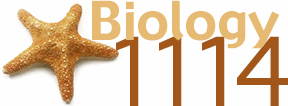
For a printable copy of this page click here.

Scenario: Welcome to the annual family reunion! All the folks here today at the lake are having a wonderful time eating and talking about their health problems. Several family members relate their cancer survival stories (Fred liver cancer; Sandra skin cancer; Glenda breast cancer) and discuss the impact that one child with
cystic fibrosis has had on their lives. We use this family's stories as an entry point for discussion of Mendelian genetics, cell division, gene expression, cancer development, and biotechnology.
|
Icon
Key:
|
|
|
|
|
|
|
Examples of In-Class Discussion Questions:
Related Laboratory Experiments and Tutorials:
Lab 10: How can the genetic composition of bacteria be altered in the laboratory?
Lab 11: How can genetic material be identified in the laboratory?
Corresponding Essential Study Partner Segments:
The Essential Study Partner is part of the McGraw-Hill Web Site.
To access it go here. Then follow these relevant paths below:
- Genetics > Cell Division >
- Genetics > DNA >
- Genetics > Protein Synthesis >
- Genetics > Recombinant DNA >
Many of these are figures and accompanying text, but some are video clips that should help you see the process in action.
The site for your textbook Life by Ricki Lewis
 source
source |
Genetic Science Learning Center provides a great tutorial explaining DNA, Genes, and Protein synthesis |
 source source
|
DNA from the BEGINNING provides all sorts of information about Genetics in the form of tutorials. Under classical genetics you will find lots of help on genes, chromosomes, and inheritance. Molecular genetics will help you with DNA, RNA, replication, transcription, translation. |
 |
Scientists Cross Pigs with Spinach Scientists in Japan implant spinach genes into pigs to create healthier pork. |
| Tour of a Cell (Read about how two NPR hosts try to discover what DNA sounds like then listen to the tour) | |
| Interactive Mitosis Tutorial from San Diego State University. You can use this to review the Cell Cycle or the events of mitosis. (Note: the cell undergoing mitosis has 3 chromosomes so it is NOT diploid) | |
| Meiosis Tutorial This tutorial from the University of Arizona may help you understand what meiosis is all about. | |
| Cell Division Animations - These tutorial from from Cal State will help you understand mitosis, meiosis, rearrangement of chromosomes during meiosis and crossing over. Don't try to memorize the vocabulary (dyads, monads, etc.), these are explained in simple terms. Concentrate on the movement of the chromosomes and the results. | |
| The Cell Cycle from The Biology Project at the University of Arizona will provide you with a good explanation and a little more detail than we discuss. It explains the links to cancer as well. | |
| Steve Minchin's Learning Resources - School of Biosciences - University of Birmingham (UK) Very good site -- contains animation and interatctive tutorials on DNA, RNA, and base pairs. | |
| Biology Project: Monohybrid Cross Problem Set - Here is a place to go if you need to test your knowledge of basic genetics problems. Each question is associated with an explanation that will help guide you to the correct answer if you answer wrong. Provides a good basic tutorial. | |
| Biology Project: Sex-linked Inheritance Problem Set - Here is a place to go if you need help with basic genetics problems. Each question is associated with an explanation that will help guide you to the correct answer if you answer wrong. Provides a good basic tutorial. | |
 |
Biocomputing in a Nutshell Provides a fair amonunt of general information on amino acids and DNA. |
| Cystic fibrosis Includes interesting facts on cystic fibrosis, plus discussions on new treatments and finding a cure. | |
 |
Phenyketonuria is a autosomal recessive trait and this tutorial uses it to describe where the mutation is found and its effect at the metabolic (enzyme) and phenotypic (mental retardation) level. |
| Genetics of Cancer Read some case studies about cancer for which there is an inherited susceptibility for it to occur again; learn some of the details of how genes function and what is being learned about the genetics of cancer; talk to others about their experiences with cancer that tend to run in families. |
|
| Polymerase chain reaction (PCR) Explains what PCR is and how it is used. |
|
| Human genome project Includes a lengthy list of of articles which discuss the human genome project and has direct lenghts to the full text of these articles. |
|
| When a cell divides, what happens to its chromosomes? Drag and drop to find out if you know the answers. This exercise covers both mitosis and meiosis. |
The website for your textbook has flashcards organised by chapters. You are only responsible for topics discussed in class. For this scenario, flashcards with the Major Terms Introduced can be found in:
Chapter 8: The Cell Cycle
Chapter 9: Meiosis
Chapter 10: How Inherited Traits are Transmitted
Chapter 11: Chromosomes
Chapter 12: DNA Structure and Replication
Chapter 13: Gene Function